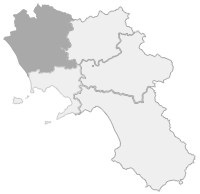Two trails with strange footprints. 58 precisely. Some in zigzags and some straight. Of human characteristics and sizes, but not exactly. And on a block of tuff at the foot of the northwestern side of the extinct volcano of Roccamonfina.
Who had ever been able to walk unharmed on the incandescent lava? The only possible answer for Foresta inhabitants, who follow that path to go to grind the wheat at the mill, was that it must have been the devil. And this is how they start calling that place the Devil ’s Footprints (Ciampate del Diavolo).
The footprints had not always been visible. They had appeared in the nineteenth century, after a period of torrential rains that hit the areas of Tora and Piccilli, the two largest villages of which Foresta was a district. The washout of the ground had brought to light that block of tuff and the marks that were imprinted on it. For almost two centuries interpreted as an inexplicable, definitely “diabolic” phenomena. Until when science studied it, which provided explanations about what was revealed as a discovery of world value. Because the footprints belonged to the first inhabitants of the area. And they dated back to the middle Pleistocene, 350 thousand years ago. When the Roccamonfina volcano was in full activity, with plinian and subplinian eruptions. And from one of them the material came, on which, when it was already cold but not yet hardened, the hominids of the “footprints” had walked. Three, with feet corresponding to a today number 34 and of around 1.60 meters high. Measurements deduced also by other clear footprints, which tell a daily story at the dawn of human presence in Italy.
There are not bipedal tracks in Italy preceding the Tora and Picilli ones. Among the most ancient in the world. With the particularity that the others were found in flat sites, while the Campania one is also a very steep slope. And in fact, even proceeding extremely carefully, as the zig zag steps suggest, one of the three slipped, leaving the marks of the hip, ankles and calves imprinted and then, to get up, the one of the left hand, before continuing his way. They went in group to an area populated by animals, which left traces too. They were hominids, of the Homo heidelbergensis species, a European evolution of the African Homo ergaster, so preceding the Homo sapiens, the first of the Homo genus able to emit sounds comparable to a primordial language.
The discovery, published in 2003, revealed the existence of a fossil trail, the most ancient known, used by the modern sapiens until when it was recognised as a paleontological site and open to the public for visits.




Comments powered by CComment